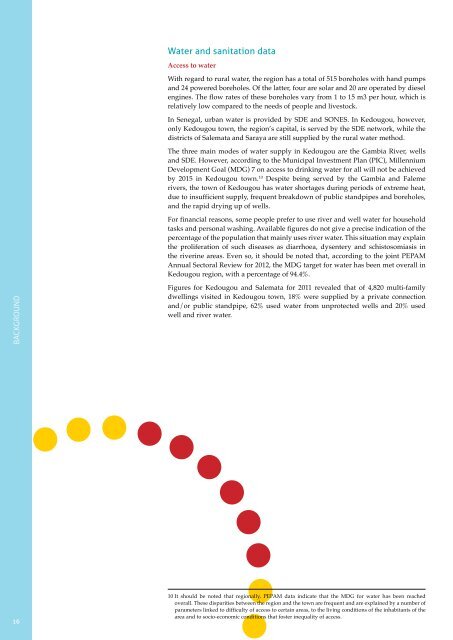1wE4FuZ
1wE4FuZ
1wE4FuZ
Create successful ePaper yourself
Turn your PDF publications into a flip-book with our unique Google optimized e-Paper software.
Water and sanitation dataAccess to waterWith regard to rural water, the region has a total of 515 boreholes with hand pumpsand 24 powered boreholes. Of the latter, four are solar and 20 are operated by dieselengines. The flow rates of these boreholes vary from 1 to 15 m3 per hour, which isrelatively low compared to the needs of people and livestock.In Senegal, urban water is provided by SDE and SONES. In Kedougou, however,only Kedougou town, the region’s capital, is served by the SDE network, while thedistricts of Salemata and Saraya are still supplied by the rural water method.The three main modes of water supply in Kedougou are the Gambia River, wellsand SDE. However, according to the Municipal Investment Plan (PIC), MillenniumDevelopment Goal (MDG) 7 on access to drinking water for all will not be achievedby 2015 in Kedougou town. 10 Despite being served by the Gambia and Falemerivers, the town of Kedougou has water shortages during periods of extreme heat,due to insufficient supply, frequent breakdown of public standpipes and boreholes,and the rapid drying up of wells.For financial reasons, some people prefer to use river and well water for householdtasks and personal washing. Available figures do not give a precise indication of thepercentage of the population that mainly uses river water. This situation may explainthe proliferation of such diseases as diarrhoea, dysentery and schistosomiasis inthe riverine areas. Even so, it should be noted that, according to the joint PEPAMAnnual Sectoral Review for 2012, the MDG target for water has been met overall inKedougou region, with a percentage of 94.4%.BackgroundFigures for Kedougou and Salemata for 2011 revealed that of 4,820 multi-familydwellings visited in Kedougou town, 18% were supplied by a private connectionand/or public standpipe, 62% used water from unprotected wells and 20% usedwell and river water.1610 It should be noted that regionally, PEPAM data indicate that the MDG for water has been reachedoverall. These disparities between the region and the town are frequent and are explained by a number ofparameters linked to difficulty of access to certain areas, to the living conditions of the inhabitants of thearea and to socio-economic conditions that foster inequality of access.



